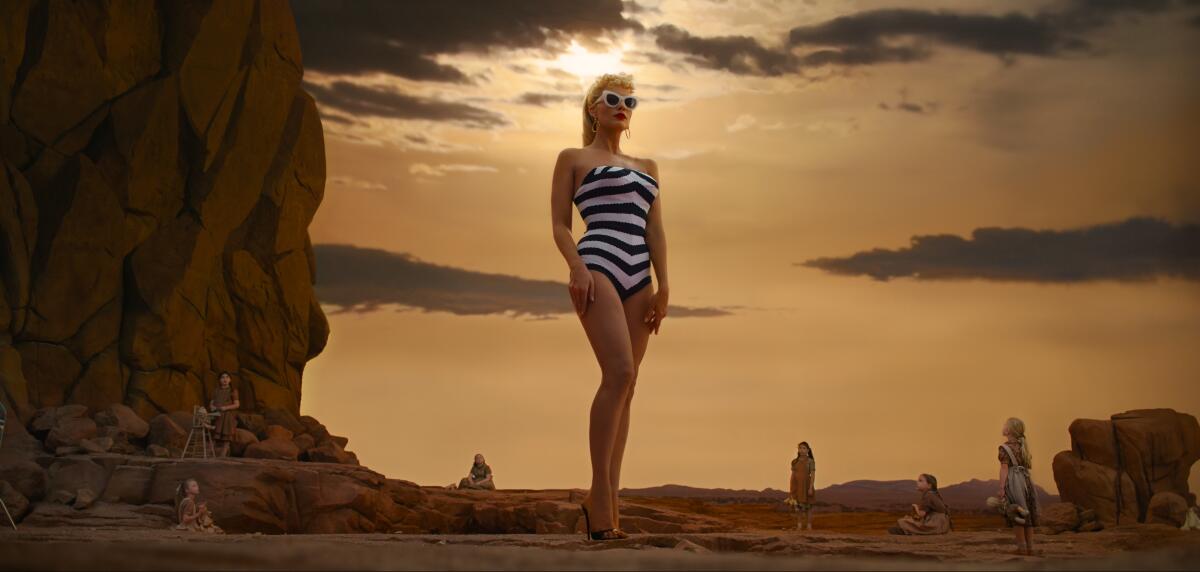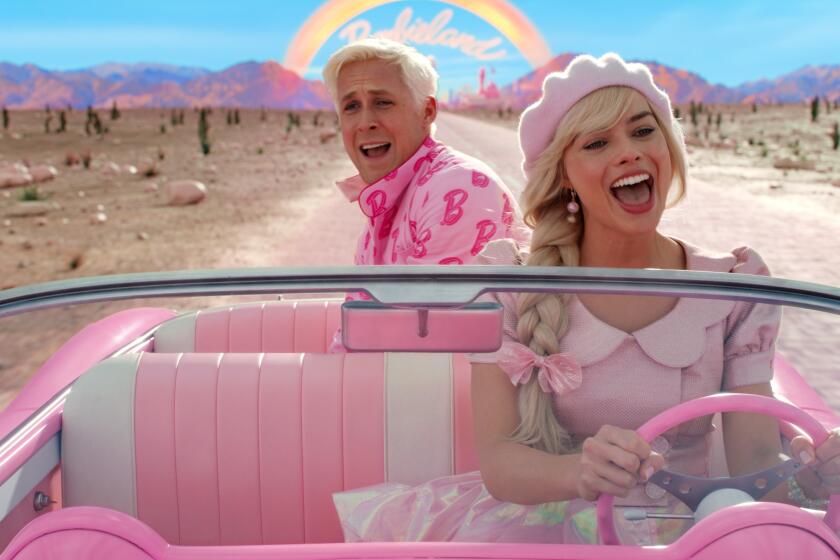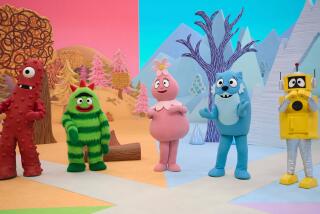Column: I’m going to Barbie Land

- Share via
It’s my full-time job but wallowing in our broken politics can sometimes make for a dark world. Why wouldn’t I look forward to going to Barbie Land and immersing myself in a fantasia of pink?
Bring on Greta Gerwig’s “Barbie,” and with it, I hope, a more sympathetic view of the most famous doll on the planet. Let the longtime feminist flashpoint become the superhero that rescues movie theaters this summer. Gerwig had me at the trailer.
Opinion Columnist
Jackie Calmes
Jackie Calmes brings a critical eye to the national political scene. She has decades of experience covering the White House and Congress.
Barbie and I grew up together. From 1959 — the year that my younger sister Patty and I each ripped the Christmas wrapping from a cardboard panel that held the brand-new Ponytail Barbie and about a half-dozen chic outfits — we all, Barbie included, weathered the societal upheavals that roiled women’s lives through the subsequent decades.
The earliest changes in our world were good ones: Our Catholic parents celebrated the election of the first president of our faith, and Patty and I replaced Ponytail Barbie with the new Bubble Cut Barbie inspired by glamorous First Lady Jackie Kennedy. We also got Barbie’s Dreamhouse and her Austin-Healey sports car, salmon pink with teal bucket seats. Oh, yeah, and Ken.
The following years weren’t so great, for us or Barbie. There was President Kennedy’s death and then my dad’s; war, more assassinations and racial strife (and the debut of Christie, the first Black doll in the Barbie lineup); urban riots, including in our Ohio city, and the confounding rise of feminism. Many women, including doll-buying mothers of daughters, came to disparage Barbie (those breasts! that waist!) as a toxic totem of the Mad Men era that would leave girls with self-image issues — never mind that Barbie’s creator, Mattel co-founder Ruth Handler, was an entrepreneurial mother of two who had to overcome male opposition to Barbie (especially to the breasts).
Greta Gerwig’s ‘Barbie’ movie starring Margot Robbie and Ryan Gosling is expected to be one of the summer’s biggest hits. Here’s what you need to know about the film.
In 1972, I graduated from high school to college. And Mattel reported a decline in Barbie sales for the first time. In a process that would repeat itself in coming eras, the company went into crisis mode to reimagine Barbie for the changing times. My younger sisters Cathy and Connie, and millions of other girls worldwide, were sold on Barbie’s makeover, literally.
By then, I’d outgrown Barbie, as we say. Alas, Mom unloaded my mint-condition Barbie treasures, and Patty’s, at a garage sale. But even as I came to call myself a feminist, I never disavowed the doll or questioned what Barbie represented — that was as varied as the girls who project themselves onto her. The Barbiephobes might say I became a feminist despite Mattel’s sexist grooming. They probably never played with Barbie.
That was certainly true of another (older) woman from Toledo, Ohio, and my early idol, Gloria Steinem: “I’m so grateful that I didn’t grow up with Barbie,” she says at the start of Andrea Nevins’ 2018 documentary, “Tiny Shoulders: Rethinking Barbie.” “Thank God! Barbie was everything we didn’t want to be, and were being told to be.”
Looking at her history and evolution, Barbie is clearly a strong, independent woman — the sort advocated by all four waves of feminism.
Poor, deprived Steinem! She had it all wrong. (In fairness, by the documentary’s end, she is grudgingly complimentary about Mattel’s 2016 launch of four new Barbies in more realistic shapes.)
Yes, the original bosomy Barbies my sister and I found under the Christmas tree in 1959 came dressed in a strapless black-and-white striped swimsuit and high heels, along with a wedding dress. But our Barbies also came with the shimmering black gown of a chanteuse, complete with standup mic and long black gloves — hardly the get-up of a woman with her mind set only on marriage. Soon came “Busy Gal” Barbie with a portfolio of fashion sketches — she didn’t just model fashion, she designed it — and “Career Girl” Barbie and “Miss Astronaut.”
Barbie’s original house had no kitchen. We didn’t miss it. The Barbie pad had books, a school pennant on the wall and a modern stereo TV set. And it was all hers, at a time when women weren’t able to qualify for credit without a co-signer. Barbie didn’t have a baby carriage; she had that sports car.
And Ken? He was just an accessory. Not that we girls disliked boys — we just were too busy living our dreams with Barbie to bother with him. So much for the critique that Barbie girls lived to catch a man. Gerwig and actor Ryan Gosling, who plays the attention-starved Ken, reportedly milk Ken’s neediness for laughs.
Star Ryan Gosling and director Greta Gerwig open up about Ken’s journey to toxic masculinity and back in their comedy based on the iconic Mattel toys.
Everyone’s got a poor-Ken story, even Gosling. He told The Times he once found his daughter’s Ken face-down in the mud. My Ken lost hair when I dropped him on the driveway. Oops. And my sister once used a sheet of carbon paper as Ken’s blanket, despoiling his face with permanent blue ink. Patty grabbed Mom’s polish remover, only to erase the paint from his eyes and mouth. She got over it. Now, if it had been Barbie…
A dozen years into my career, I had a daughter and gave her a Barbie for her first birthday. Believe me, I wasn’t signaling that I hoped she’d become a sex object. Sarah never played with it. My second daughter, Carrie, did. But she disrespected Barbie — or Barbies, plural; by then girls had multiple Barbies at a time. I found their shorn hair floating in the toilet.
Neither daughter’s dismissive attitude upset me. So what if they didn’t love Barbie as Patty and I did? They pursue their own pleasures, and dreams. As they should. But they also share in mine. And this week, Sarah will accompany me to Barbie Land.
More to Read
Get the latest from Jackie Calmes
Commentary on politics and more from award-winning opinion columnist.
You may occasionally receive promotional content from the Los Angeles Times.















